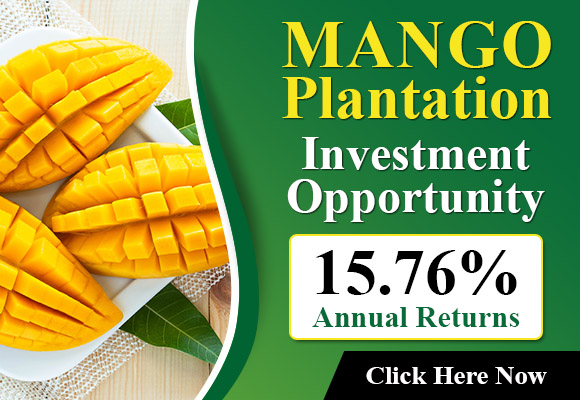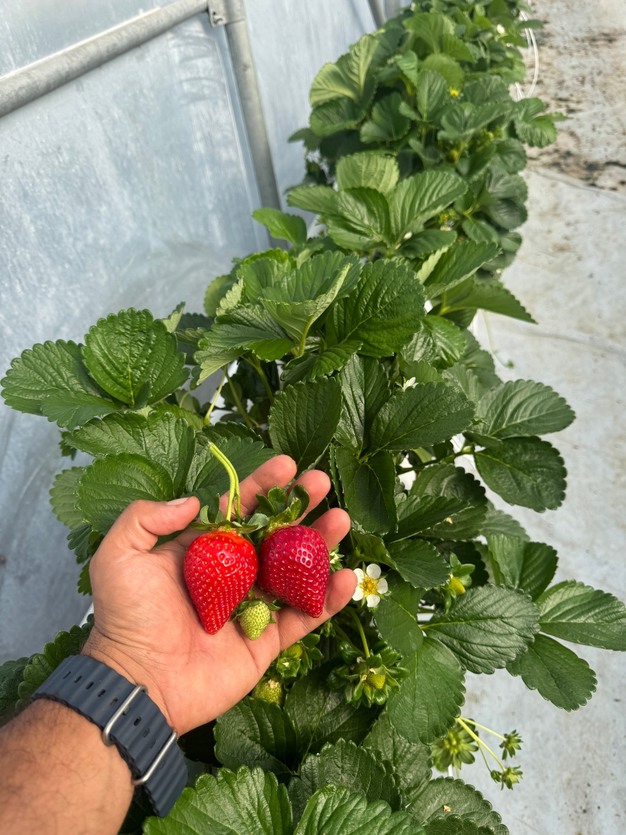 © Fertile Land Ltd.
© Fertile Land Ltd.
With Phytoftora, the lack of water available, and pests like thrips challenging outdoor cultivation of strawberries in Greece, there’s a need for alternative producing methods. Recently, a 2-hectare tomato greenhouse has been refitted to fit the needs of strawberry production. “We have a strictly biological approach, tackling thrips and spider mites using IPM and beneficials only”, project lead Andreas Lypas says. Biostimulant support helps the plants withstand extremely high temperatures.
“This marks the first time in Greece that we’ve made a complete switch to hydroponic strawberry production on this scale”, says Andreas Lypas. The concept originated from his background in soft fruit production in the UK and Scotland, and he collaborated with an investor to finalize the project. “The key was always flavour and shelf life. I saw the opportunity to repurpose an existing tomato greenhouse for strawberry production, despite the structural limitations of a non-purpose-built facility. With careful planning and technical adjustments, we moved ahead.”
“Together with the investor, we decided to transplant in three phases, aiming to reach peak production during the summer, while still maintaining quality at the beginning and end of the season. That’s when outdoor production is highly compromised. Heat stress above 38–40°C affects flowering, fruit quality, and overall plant vitality. ” The project is located in southern Greece, approximately one hour from Athens. It’s the first time a strawberry facility of this scale has been established and planting and harvesting are currently in full swing.
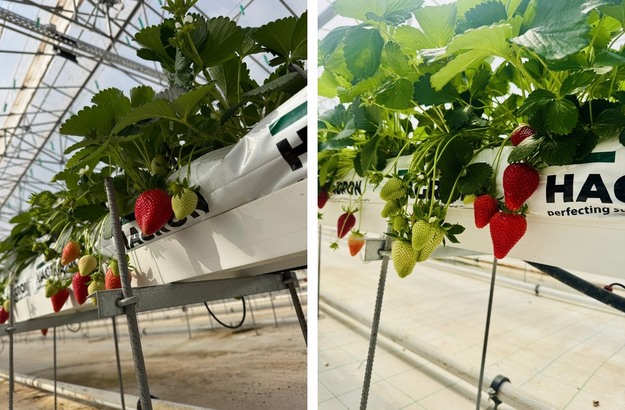 © Fertile Land Ltd.
© Fertile Land Ltd.
The production model is based on hydroponically grown strawberries in coir, using trayplants. Fertigation, climate strategy, and biological controls are all managed under Andreas’ agronomic supervision. “The transplanting was done in three stages — December, March, and May — each covering 0.5 hectares. This scheduling helped distribute labour and resource needs, and ensured a steady supply of fruit through the summer season,” he explains.
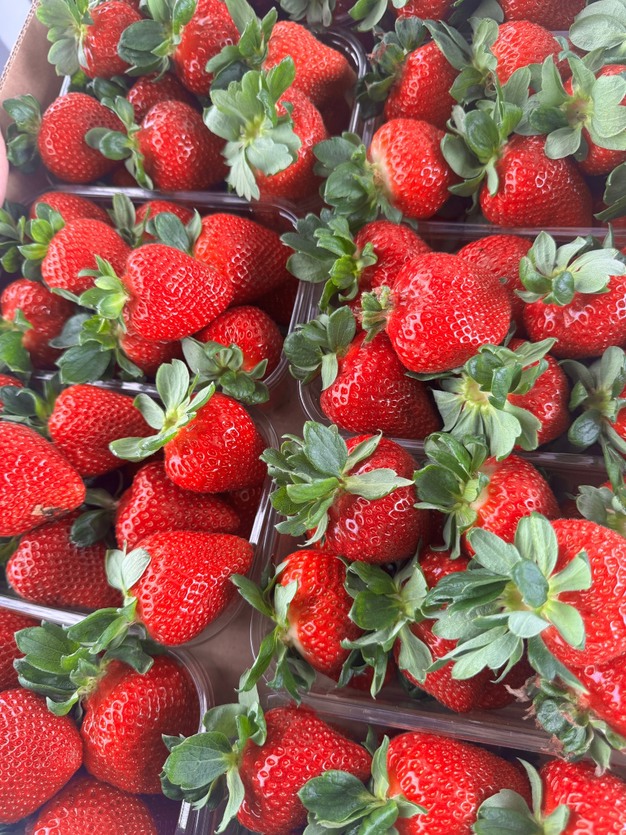 © Fertile Land Ltd.
© Fertile Land Ltd.
Phase 1, initiated in December, used a June-bearing cultivar planted at a density of 2.5 plants/m², constrained by the existing tomato infrastructure. Yields have reached around 0.7 kg per plant so far. According to Andreas, even within these limitations, the results were promising, as fruit structure, shelf life, and flavour have been consistent under this model.
Phase 2, started at the end of March, introduced an everbearing variety. “We were able to adjust the layout and increase planting density to 3 plants/m². Yields are already exceeding 0.5 kg per plant and are expected to peak soon,” Andreas says.
Phase 3, transplanted in mid-May, continues with the same planting density and is now in early harvest. Yield data is still being collected, but the crop appears stable despite recent outdoor temperatures exceeding 43°C.
The facility uses passive cooling through large-scale ventilation and shading systems, and active pad-and-fan cooling. “We combine it with strategic irrigation and early harvest cycles to manage heat stress. More active cooling technologies such as high-pressure fogging and shading screens are under evaluation for future expansions,” Andreas notes.
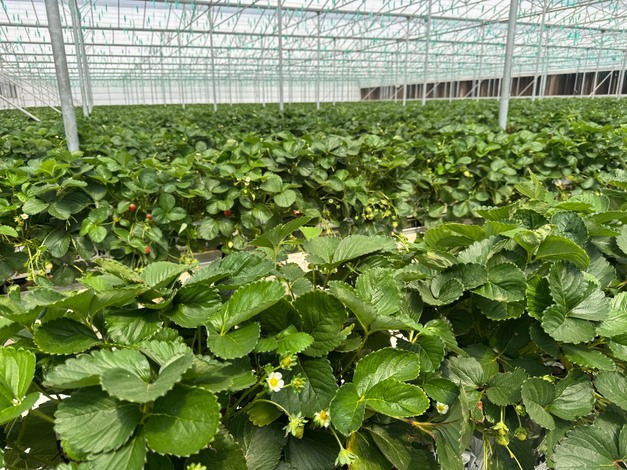 © Fertile Land Ltd.
© Fertile Land Ltd.
Environmental monitoring tools include EC and moisture sensors in the substrate and a centralised fertigation unit to regulate inputs. Andreas highlights the use of biostimulants for plant resilience and a biological pest management system. “We’re using no insecticides. Thrips and spider mites are being controlled entirely through IPM and beneficials. This approach aligns with residue-free market expectations.”
Andreas also comments on the broader context: “Phytophthora remains a key issue in open-field production here, especially on heavier soils. Combined with water availability challenges and pest pressure, open-field strawberries during summer are increasingly unfeasible. Heat stress above 38–40°C affects fruit quality and plant health. Protected cultivation offers more control.”
Labour is another ongoing factor. “It’s not just about cost — it’s also about availability and reliability. Like elsewhere in Europe, seasonal labour is harder to secure, and soft fruit crops require experienced workers,” he adds.
As of now, the greenhouse is in its first full production cycle. Expansion is under consideration, pending the results of the late-summer harvest. “There’s clearly growing interest in protected cultivation in Greece. Given the combination of climate volatility, water stress, and stricter plant protection regulations, I believe more growers will turn to controlled environments,” Andreas concludes. ” I believe we’re just at the beginning of this transition.”

For more information:
Fertile Land
[email protected]
www.fertilelandltd.com
Source: The Plantations International Agroforestry Group of Companies
